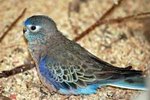Cartoons may make it seem that cats and birds can never get along, but with the right training, the opposite can be true. When you bring home a pet bird, it's important not to separate your cat and bird by placing the cage in a closed-off room or portion of the house that isn't accessible to your cat. Creating space between your pets will only pique your cat's curiosity and predatory instincts, and may result in tragedy in the event someone forgets to close your bird's cage and it escapes into the house. To train your cat not to attack your bird, there are certain steps you can take.
Cage
The first step in training cats not to attack pet birds is to buy a large, sturdy cage to house and protect your bird. Do not buy a light cage with wide bars that a cat can either topple off a shelf or table, or stick paws through to swipe at the bird. Your bird must have enough space to move freely inside the cage and away from your cat, who may peer through the bars. The bars of your bird cage should be spaced no more than one-half inch apart. Heavier bird cages are made from stainless steel or wrought iron.
Placement
Find a place for your bird cage that will allow your curious cat to inspect its perimeter and contents. To lessen your bird's stress from being surveyed, place visual barriers inside the cage such as branches or toys that can allow your bird to hide if it gets scared by your cat. Do not keep your cage on the ground. Instead, place it on a table or stable low shelf where it cannot be easily knocked over. It's important to make the bird cage somewhat accessible to your cat to make it more accustomed to being around your bird. The more acclimated your cat gets around your bird, the more likely it will not attack in the event you are not around.
Supervision
Once you have found proper placement for your cage, your cat will likely be very curious and want to explore your bird, according to bird resource Avian Web (avianweb.com). Supervision is key during this phase of training since cats are naturally predatory and instinctively may want to hunt birds in close proximity. Watch your cat as it explores the perimeter of your bird cage. After a few days of this, allow your cat to smell your bird as you hold it safely in your hands. Closely monitor your cat's movements and loudly yell, "No," if it hisses at your bird or tries to play with it by swatting at its head as you hold it.
Persistence
Persistence is key when it comes to training cats around pet birds. Continue to allow your cat to grow accustomed to your bird while it is in its cage. Also, continue to allow regular and closely supervised interaction between your cat and bird outside of the bird cage until you feel your cat has grown comfortable around your bird. Praise your cat when it approaches your bird in a nonthreatening way.
References
Photo Credits
-
Keystone/Valueline/Getty Images
Writer Bio
Crystal Vogt has been an editor and freelance writer since 2005 and has had her work mentioned on MediaBistro, Yahoo! Finance and MSN Money, among other outlets. She received her M.S. in journalism from Boston University and holds a B.A. in English from UC Santa Barbara.




